Five-leaf akebia
 I'd like to draw the attention of the garden enthusiasts to this interesting though still rarely encountered climber, valued chiefly for its leaves, but having also very unusual flowers and fruits that are often overlooked since they are not easily noticeable.
I'd like to draw the attention of the garden enthusiasts to this interesting though still rarely encountered climber, valued chiefly for its leaves, but having also very unusual flowers and fruits that are often overlooked since they are not easily noticeable.
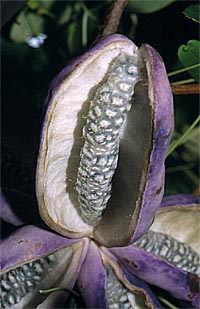 Intriguing fruits of Akebia, photo S. Marczyński Intriguing fruits of Akebia, photo S. Marczyński |
Szczepan Marczyński
Five-leaf Akebia (Akebia quinata) is native to Far East (China, Japan, Korea). It is a climbing shrub with twining stems that attains a height of up to 5-6 m (1-3 m annually). It has palmate deep green leaves composed of 5 leaflets (similar to Schefflera). It is semi-evergreen and only sheds the leaves after big freeze. In May small chocolate-purple clusters appear in the leaf axils. They consist of female flowers of 2-3 cm in diameter, and a few smaller (0,5-1 cm in diameter) male flowers.
Dark blooms, hidden among the leaves are not easy to spot, but they give off a slightly spicy scent. Akebia also bears very intriguing fruits. Grouped in sets of 2-3, oblong, sausage-like pods of up to 10 cm long ripen in October. Violet outside, they crack on ripening revealing white pulpy core. Unfortunately, flowers are not easy to pollinate so the fruits are rarely set. If you want to have more of them, you may try pollinating the flowers on your own, by rubbing male flowers against the female ones.
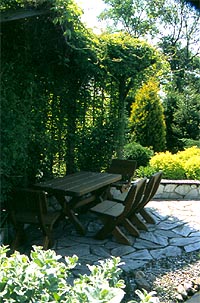 Akebia gives a nice shadow in hot days, photo S. Marczyński |
Akebia is sufficiently frost hardy to grow in a cool climate such as the Polish one. Although during severe winter it may freeze, in spring new shoots will appear at the base. Owing to its vigorous growth and attractive, thick and healthy foliage, it can quickly create a cover or a shady spot. Ideal for covering arbours, but it can be successfully trained up walls, fences, pergolas, arches and various garden supports.
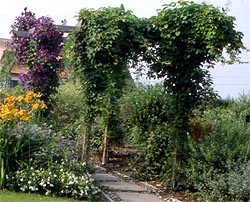 Akebia growing on an arch, photo S. Marczyński |
Akebia is suitable as a ground cover plant to cover large areas. You will achieve the best effect if you let it grow freely and prune it only when it has spread out excessively. Every 4-5 years you should thin it out by cutting out the oldest stems. Akebia can grow in all types of soils, except waterlogged or very dry ones. It tolerates well alkaline soils and will thrive in every aspect from half shade to full sun.
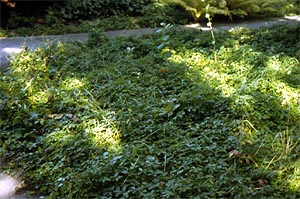 Akebia as a cover, photo J.Borowski | 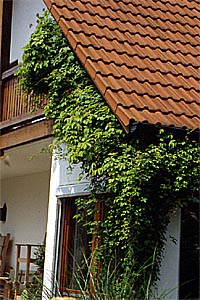 Akebia growing on a house, photo S. Marczyński Akebia growing on a house, photo S. Marczyński |













